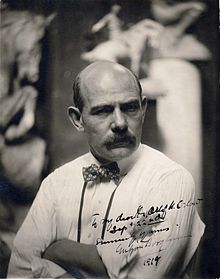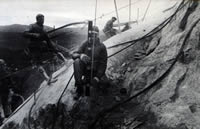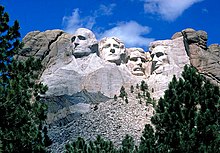Construction of Mount Rushmore: Difference between revisions
DJ Clayworth (talk | contribs) m Reverted edits by 164.223.72.5 (talk) to last version by 86.129.176.240 |
→Designing the monument: re "cast", and ref |
||
| Line 6: | Line 6: | ||
[[Doane Robinson]] of the [[South Dakota Historical Society]] wanted a monument to be built in [[South Dakota]] in order to help the economy of the state by attracting tourism. In 1923, he proposed that this monument should be built from the [[granite]] cliffs in the [[Black Hills]] of [[South Dakota]]. Senator [[Peter Norbeck]] of South Dakota approved of the proposal, and federal funds helped the project. Robinson asked architect and sculptor [[Gutzon Borglum]] to sculpt and design the monument. Borglum decided to use Mount Rushmore for the sculpture, since it appeared the easiest of the cliffs to work on.<ref>[http://media.graniteschools.org/Curriculum/mt_rush/idea.htm Mt. Rushmore - "An Idea in the Mind"]</ref> |
[[Doane Robinson]] of the [[South Dakota Historical Society]] wanted a monument to be built in [[South Dakota]] in order to help the economy of the state by attracting tourism. In 1923, he proposed that this monument should be built from the [[granite]] cliffs in the [[Black Hills]] of [[South Dakota]]. Senator [[Peter Norbeck]] of South Dakota approved of the proposal, and federal funds helped the project. Robinson asked architect and sculptor [[Gutzon Borglum]] to sculpt and design the monument. Borglum decided to use Mount Rushmore for the sculpture, since it appeared the easiest of the cliffs to work on.<ref>[http://media.graniteschools.org/Curriculum/mt_rush/idea.htm Mt. Rushmore - "An Idea in the Mind"]</ref> |
||
Gutzon Borglum, having decided on the location of the sculpture, decided to make this monument of four [[President of the United States|Presidents of the United States]]. He chose the two most famous Presidents in history, [[George Washington]] and [[Abraham Lincoln]]. He chose [[Thomas Jefferson]] because Jefferson nearly doubled the size of the United States in the 1803 [[Louisiana Purchase]]. The last President Borglum chose was [[Theodore Roosevelt]], suggested by President [[Calvin Coolidge]] because of Theodore Roosevelt's introduction of the [[National Park Service]]. |
Gutzon Borglum, having decided on the location of the sculpture, decided to make this monument of four [[President of the United States|Presidents of the United States]]. He chose the two most famous Presidents in history, [[George Washington]] and [[Abraham Lincoln]]. He chose [[Thomas Jefferson]] because Jefferson nearly doubled the size of the United States in the 1803 [[Louisiana Purchase]] (which included the land that became South Dakota). The last President Borglum chose was [[Theodore Roosevelt]], suggested by President [[Calvin Coolidge]] (who insisted there be two [[Republican Party (United States)|Republicans]] and only one [[Democratic Party (United States)|Democrat]] represented.<ref name=Fite>Fite, Gilbert C. ''Mount Rushmore'' (May 2003). ISBN 0-9646798-5-X.</ref>) because of Theodore Roosevelt's introduction of the [[National Park Service]]. |
||
Borglum worked on his design of the four Presidents in his studio in [[Stone Mountain]], [[Georgia (U.S. state)|Georgia]]. He invented a machine that would scale the model at 1 inch on his model to 1 foot on Mount Rushmore. The original design had the Presidents head to waist, but due to high costs, only the heads were completed. |
Borglum worked on his design of the four Presidents in his studio in [[Stone Mountain]], [[Georgia (U.S. state)|Georgia]]. He invented a machine that would scale the model at 1 inch on his model to 1 foot on Mount Rushmore. The original design had the Presidents head to waist, but due to high costs, only the heads were completed.{{fact}} |
||
==Construction== |
==Construction== |
||
Revision as of 18:59, 10 August 2009
This article needs additional citations for verification. (August 2009) |

The construction of Mount Rushmore National Memorial took about 14 years, from 1927 to 1941.
Designing the monument
Doane Robinson of the South Dakota Historical Society wanted a monument to be built in South Dakota in order to help the economy of the state by attracting tourism. In 1923, he proposed that this monument should be built from the granite cliffs in the Black Hills of South Dakota. Senator Peter Norbeck of South Dakota approved of the proposal, and federal funds helped the project. Robinson asked architect and sculptor Gutzon Borglum to sculpt and design the monument. Borglum decided to use Mount Rushmore for the sculpture, since it appeared the easiest of the cliffs to work on.[1]
Gutzon Borglum, having decided on the location of the sculpture, decided to make this monument of four Presidents of the United States. He chose the two most famous Presidents in history, George Washington and Abraham Lincoln. He chose Thomas Jefferson because Jefferson nearly doubled the size of the United States in the 1803 Louisiana Purchase (which included the land that became South Dakota). The last President Borglum chose was Theodore Roosevelt, suggested by President Calvin Coolidge (who insisted there be two Republicans and only one Democrat represented.[2]) because of Theodore Roosevelt's introduction of the National Park Service.
Borglum worked on his design of the four Presidents in his studio in Stone Mountain, Georgia. He invented a machine that would scale the model at 1 inch on his model to 1 foot on Mount Rushmore. The original design had the Presidents head to waist, but due to high costs, only the heads were completed.[citation needed]
Construction

A few hundred workers, who were usually miners, sculptors, or rock climbers, used dynamite, jackhammering, and chiseling to sculpt the model from the mountain. A stairway was constructed to the top of the mountain first and ropes fixed. Workers were supported by harnesses attached to the ropes.
The irises of the eyes were sculpted as holes. A cube of granite was left in each to represent the reflection highlight thereby making the appearance of the eyes more realistic.
Construction began on August 10, 1927.
George Washington

George Washington's head was started first. Due to the economic instability of the United States caused by the Great Depression, it was completed in seven years, and dedicated to the public on Independence Day 1934. A large American flag was placed over Washington's head before it was revealed, and this became a tradition for each of the President's heads.
Thomas Jefferson
Thomas Jefferson's head was started next, on Washington's right. Before the head was complete, Borglum ordered that it be blasted off due to poor rock quality. Jefferson's head was started again to the left of Washington. Jefferson's head was dedicated in 1936.
Abraham Lincoln
Abraham Lincoln's head was more of a challenge because of his beard, but his head was completed on the far right of the cliff, dedicated on September 17, 1937, the 150th anniversary of the signing of the Constitution of the United States in 1787.
Theodore Roosevelt
While Theodore Roosevelt's head was being constructed, accommodations for tourists were being built, including plumbing, lighting, and a visitor center. On July 2, 1939, Roosevelt's head was dedicated.
Hall of Records
Due to unforeseen vulnerabilities in the granite, Lincoln and Jefferson were moved from the locations in Borglum's original design. Lincoln was relocated to the spot that Borglum had planned to include an 80 by 100 foot inscription in the shape of the Louisiana Purchase.
To replace the inscription, Borglum conceived another grand addition to the monument of similar proportions: the Hall of Records. The Hall of Records was to include a grand entrance to an 80 by 100 foot vault carved directly into the granite face of the small canyon behind Lincoln’s head. Borglum envisioned 800 granite steps leading from his studio to the entrance of the Hall.
In 1938 Borglum and his crew began to carve this grand hall, where he envisioned the original Declaration of Independence and United States Constitution should eventually be stored. But a combination of unexpectedly hard granite, looming war in Europe, and lack of funding conspired against Borglum’s last dream, though his plans became more elaborate as his team rushed to complete this work. They reached 70 feet into the granite by the time Borglum unexpectedly died in March 1941. The monument was deemed complete and all work shut down on October 31 of the same year. Though Borglum’s children tried over the years to renew interest in their father’s last dream, it was not until 1998 that the National Park System, together with the Borglum Family, put “finishing touches” on the Hall of Records. A titanium vault was installed in the granite floor of the unfinished hall, and filled with sixteen porcelain enamel panels that include the United States Constitution and other important historical documents. The Hall of Records entrance can be seen from west-facing aerial photographs of the monument from Live Search Maps.[3][4]
Present day

Since the excess granite remains that were dropped to the ground from dynamite explosions and chiseling were nearly impossible to remove, they were left as part of the site. The monument has received much criticism from the Native Americans in the Black Hills area, but Doane Robinson's original vision of boosting the South Dakotan economy was a success, as the site receives millions of visitors annually.
References
- ^ Mt. Rushmore - "An Idea in the Mind"
- ^ Fite, Gilbert C. Mount Rushmore (May 2003). ISBN 0-9646798-5-X.
- ^ Hall of Records
- ^ Mt. Rushmore in Birds Eye at the Microsoft Virtual Earth Blog
